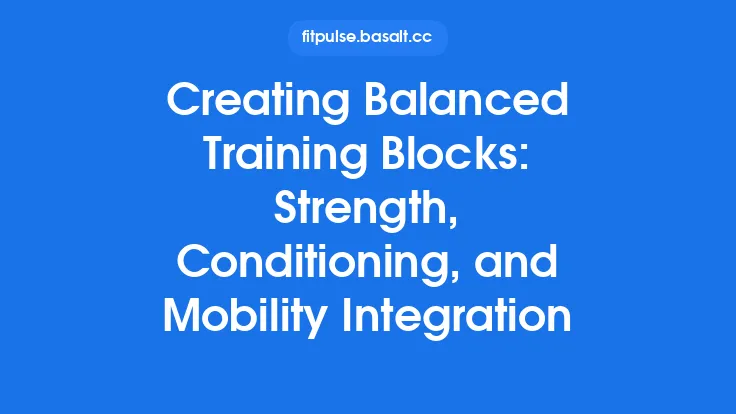A well‑designed warm‑up does more than raise body temperature; it primes the nervous system, awakens the connective tissues, and creates the joint space needed for safe, efficient movement. When the shoulders, hips, ankles, and spine are all given focused attention, the entire kinetic chain becomes more resilient, allowing you to lift heavier, run faster, and stay injury‑free for years to come. This article walks you through the science behind joint‑centric warm‑ups, outlines the key principles that make them effective, and provides a step‑by‑step routine that you can slot into any training session—whether you’re a beginner learning the basics or an advanced athlete fine‑tuning performance.
Why a Joint‑Focused Warm‑Up Matters
- Neuromuscular Activation
Mobility drills stimulate proprioceptors (muscle spindles, Golgi tendon organs, and joint capsule receptors) that sharpen the brain‑muscle connection. This heightened awareness translates to better motor unit recruitment and timing during the main workout.
- Synovial Fluid Distribution
Gentle, controlled movement encourages the production and circulation of synovial fluid, which lubricates the articular surfaces. Adequate lubrication reduces friction, improves glide, and protects cartilage from wear.
- Fascial Tension Release
The fascia that envelops muscles and joints can become stiff from prolonged sitting or repetitive patterns. Dynamic stretches create low‑intensity shear forces that remodel fascial layers, allowing a greater range of motion without compromising stability.
- Injury Prevention
By moving each joint through its functional range before loading, you expose any deficits (e.g., limited external rotation in the shoulder or ankle dorsiflexion restriction) early, giving you the chance to correct them before they become injury triggers.
Principles of an Effective Mobility Warm‑Up
| Principle | Practical Application |
|---|---|
| Specificity | Target the joints you’ll stress most in the upcoming activity. For a squat‑heavy session, prioritize hip, ankle, and spine mobility; for a bench‑press day, add shoulder work. |
| Progressive Load | Begin with low‑intensity, high‑repetition movements (e.g., arm circles) and gradually increase the range, speed, or external load (e.g., band‑assisted shoulder rotations). |
| Dynamic Over Static | Use movement‑based drills that mimic the patterns of the main workout. Static holds are better suited for post‑training flexibility work. |
| Time Efficiency | Aim for 10–15 minutes total; a well‑structured sequence can activate all four major joints without sacrificing training volume. |
| Individualization | Adjust the volume, intensity, and complexity based on age, training level, and any pre‑existing limitations. |
Dynamic Shoulder Mobility Sequence
- Scapular Wall Slides (2 × 10 reps)
- Stand with back, hips, and head against a wall. Press forearms and hands flat while sliding them upward, keeping the scapulae depressed and retracted.
- Why it works: Enhances scapulothoracic upward rotation and posterior capsule flexibility, essential for overhead and pressing movements.
- Band‑Assisted External Rotations (3 × 12 reps per side)
- Anchor a light resistance band at elbow height. With the elbow tucked to the side, pull the band outward, keeping the forearm parallel to the floor.
- Why it works: Strengthens the rotator cuff while stretching the posterior capsule, improving glenohumeral stability.
- Arm Circles with Progressive Range (30 seconds forward, 30 seconds backward)
- Start with small circles, gradually expanding to full arm length. Keep the shoulders relaxed and avoid shrugging.
- Why it works: Increases blood flow, warms the deltoids, and mobilizes the glenohumeral joint through its full circumduction.
- Thoracic “Thread‑the‑Needle” (2 × 8 reps per side)
- From a quadruped position, slide one arm under the opposite arm, rotating the thoracic spine, then return to start.
- Why it works: Couples shoulder external rotation with thoracic rotation, promoting coordinated mobility across the shoulder‑spine complex.
Hip Mobility Activation
- Hip CARs (Controlled Articular Rotations) – 2 × 5 reps per direction
- Stand on one leg, lift the opposite knee, and draw a large circle with the hip joint, moving through flexion, abduction, extension, and adduction. Keep the torso upright.
- Why it works: Provides a comprehensive assessment and warm‑up of the hip’s capsular limits while reinforcing motor control.
- World’s Greatest Stretch (1 × 5 reps per side)
- From a lunge, place the opposite hand on the ground, rotate the torso toward the front leg, reaching the arm overhead. Return to lunge and repeat.
- Why it works: Simultaneously opens the hip flexors, adductors, and thoracic spine, creating a functional stretch that mirrors many sport‑specific movements.
- Banded Lateral Walks (3 × 10 steps each direction)
- Place a mini‑band around the knees or ankles, maintain slight knee bend, and step laterally while keeping tension on the band.
- Why it works: Activates the gluteus medius and minimus, which are key for hip stability during single‑leg tasks.
- Dynamic Frog Stretch (2 × 30 seconds)
- Kneel with knees wide, toes pointing outward, and gently rock forward and back, allowing the hips to open gradually.
- Why it works: Improves adductor and groin flexibility, essential for deep squats and hip‑dominant lifts.
Ankle Mobility Circuit
- Knee‑to‑Wall Dorsiflexion (3 × 8 reps per side)
- Stand facing a wall, place the foot a few inches away, and drive the knee toward the wall while keeping the heel planted. Progress by moving the foot farther from the wall.
- Why it works: Directly targets tibialis anterior length and talocrural joint dorsiflexion, crucial for squat depth and sprint mechanics.
- Ankle Alphabet (1 × full alphabet per foot)
- Seated or lying down, “write” the letters of the alphabet with the big toe, moving only the ankle joint.
- Why it works: Provides a low‑load, high‑range movement that mobilizes the subtalar and talocrural joints in multiple planes.
- Heel‑Elevated Calf Raises (2 × 12 reps)
- Stand on a small platform, lower the heels below the platform, then rise onto the toes.
- Why it works: Stretches the gastrocnemius and soleus while strengthening the plantarflexors, balancing ankle mobility with strength.
- Standing Hip‑to‑Toe Rock (2 × 30 seconds)
- From a half‑squat position, rock forward onto the toes, then back onto the heels, allowing the ankle to move through its full range.
- Why it works: Encourages coordinated ankle dorsiflexion/plantarflexion with hip flexion/extension, mirroring the mechanics of running and jumping.
Spine Mobility Integration
- Cat‑Cow Flow (3 × 10 reps)
- From quadruped, alternate arching (cow) and rounding (cat) the back, moving slowly and breathing with each segment.
- Why it works: Mobilizes the entire vertebral column, especially the lumbar and thoracic regions, while activating the core stabilizers.
- Standing Side‑Bends with Reach (2 × 8 reps per side)
- Stand tall, raise one arm overhead, and lean laterally, feeling a stretch along the opposite flank. Return to neutral and repeat.
- Why it works: Improves lateral flexion and rib‑cage mobility, beneficial for overhead lifts and rotational sports.
- Hip‑Hinge to Thoracic Rotation (2 × 6 reps per side)
- Perform a hip hinge (like a deadlift start), then rotate the upper torso toward the lifted arm, keeping the hips stable.
- Why it works: Couples lumbar stability with thoracic rotation, reinforcing the “hinge‑rotate” pattern used in many athletic movements.
- Supine “Dead‑Bug” with Pelvic Tilt (2 × 10 reps)
- Lying on the back, arms extended toward the ceiling, knees bent 90°. Press the lower back into the floor, then extend opposite arm and leg while maintaining the tilt.
- Why it works: Teaches lumbar-pelvic control, a cornerstone of spinal health and functional movement.
Putting It All Together: Sample 15‑Minute Routine
| Time | Drill | Sets × Reps | Focus |
|---|---|---|---|
| 0‑2 min | Scapular Wall Slides | 2 × 10 | Shoulder girdle activation |
| 2‑4 min | Hip CARs | 2 × 5 each direction | Full hip capsule mobilization |
| 4‑5 min | Knee‑to‑Wall Dorsiflexion | 3 × 8 each side | Ankle dorsiflexion |
| 5‑6 min | Cat‑Cow Flow | 3 × 10 | Spinal fluid circulation |
| 6‑7 min | Arm Circles (progressive) | 30 s each direction | Dynamic shoulder range |
| 7‑8 min | World’s Greatest Stretch | 1 × 5 each side | Integrated hip‑spine stretch |
| 8‑9 min | Banded Lateral Walks | 3 × 10 each direction | Hip stability |
| 9‑10 min | Ankle Alphabet | 1 × full alphabet each foot | Subtalar mobility |
| 10‑11 min | Thoracic Thread‑the‑Needle | 2 × 8 each side | Thoracic rotation |
| 11‑12 min | Standing Side‑Bends with Reach | 2 × 8 each side | Lateral spinal flexibility |
| 12‑13 min | Hip‑Hinge to Thoracic Rotation | 2 × 6 each side | Coordinated hinge‑rotate |
| 13‑15 min | Supine Dead‑Bug with Pelvic Tilt | 2 × 10 each side | Core‑spine integration |
Tip: Perform each movement deliberately, focusing on the quality of motion rather than speed. If a particular drill feels tight, linger a few extra seconds or add a light band/foam‑roller cue to increase the stretch.
Adapting the Routine for Different Populations
| Population | Modifications |
|---|---|
| Beginners / Older Adults | Reduce range (e.g., shallow hip CARs), use lighter bands, increase rest between sets, and prioritize pain‑free motion. |
| Athletes (Power/Speed) | Add light external load (e.g., PVC pipe for shoulder circles), increase tempo for dynamic drills, and integrate sport‑specific patterns (e.g., single‑leg ankle dorsiflexion for sprinters). |
| Rehabilitation Clients | Focus on joint capsular end‑range only after clearance, incorporate isometric holds at comfortable angles, and use manual therapist cues for proprioceptive feedback. |
| Travelers / Limited Space | Substitute wall slides with towel slides, use a resistance band for external rotations, and perform ankle alphabet while seated. |
Common Mistakes and How to Fix Them
- Rushing Through the Range – Moving too fast sacrifices joint fluid circulation. Fix: Adopt a 2‑second eccentric, 1‑second pause, 2‑second concentric tempo for most drills.
- Compensating with the Lower Back – During hip or shoulder drills, the lumbar spine often “takes over.” Fix: Engage the core (draw the belly button toward the spine) and keep the pelvis neutral.
- Neglecting Opposite‑Side Mobility – Focusing only on the dominant side creates asymmetry. Fix: Perform an equal number of reps on both sides, even if one feels easier.
- Using Excessive Load Too Early – Adding heavy bands or weights before adequate mobility can exacerbate restrictions. Fix: Start with minimal resistance; only progress when the movement feels smooth and pain‑free.
- Skipping the Warm‑Up Entirely – Some athletes jump straight into heavy lifts. Fix: Treat the mobility routine as a non‑negotiable part of the session; it only takes 15 minutes but pays dividends in performance and longevity.
Tracking Progress and Maintaining Consistency
- Baseline Assessment: Record key metrics such as shoulder external rotation angle (using a goniometer or smartphone app), hip internal rotation in 90/90 position, ankle dorsiflexion distance to wall, and thoracic rotation range. Re‑test every 4–6 weeks.
- Movement Journal: Note perceived tightness, pain, or ease after each session. Over time, patterns emerge that guide drill selection.
- Video Feedback: Record a short clip of each joint’s movement (e.g., hip CAR) and compare frame‑by‑frame to earlier recordings. Visual cues often reveal subtle improvements missed by sensation alone.
- Progressive Overload: Once a drill feels easy (e.g., you can comfortably achieve full range with a light band), increase the band tension, add a few extra reps, or incorporate a slight external load (e.g., a light dumbbell for shoulder circles).
By systematically addressing the shoulder, hip, ankle, and spine in a concise, dynamic warm‑up, you lay a solid foundation for every training session. The routine outlined above balances mobility, activation, and neuromuscular control, ensuring that each joint moves freely yet remains stable under load. Consistency, proper technique, and periodic reassessment will keep your joints supple, your movements efficient, and your performance on an upward trajectory—no matter your age or athletic ambition.





